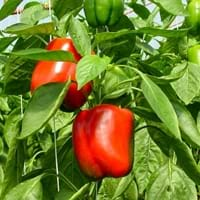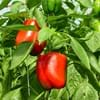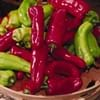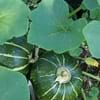Life Span
Annual
Annual and Perennial
Origin
Hybrid origin, Mexico, Central America, South America
North America, Mexico, Central America
Types
it is a type of bell paper
Winter squash, Field pumpkin, Crookneck pumpkin
Habitat
Not Available
close to waterfalls, Riverbanks, Warmer regions, waterways, Wet ground
USDA Hardiness Zone
Not Available
1-6
Sunset Zone
A1, A2, A3, H1, H2, 1a, 1b, 2a, 2b, 3a, 3b, 4, 5, 6, 7, 8, 9, 10, 11, 12, 13, 14, 15, 16, 17, 18, 19, 20, 21, 22, 23, 24
A1, A2, A3, H1, H2, 1a, 1b, 2a, 2b, 3a, 3b, 4, 5, 6, 7, 8, 9, 10, 11, 12, 13, 14, 15, 16, 17, 18, 19, 20, 21, 22, 23, 24
Habit
Upright/Erect
Vining/Climbing
Flower Color
White, Yellow, Green
Yellow
Flower Color Modifier
Bicolor
Bicolor
Fruit Color
Red, Green
Orange Red, Yellow Brown
Leaf Color in Spring
Green
Green, Light Green
Leaf Color in Summer
Green
Green, Dark Green
Leaf Color in Fall
Green, Black
Green, Dark Green
Leaf Color in Winter
Green
Not Available
Leaf Shape
Elliptic
Heart-shaped
Plant Season
Spring, Summer, Fall
Early Winter
Sunlight
Full Sun
Full Sun
Growth Rate
Medium
Very Fast
Type of Soil
Loam
Well drained
The pH of Soil
Neutral
Neutral
Soil Drainage
Well drained
Well drained
Bloom Time
Indeterminate
Summer
Tolerances
Drought
Drought
Where to Plant?
Container, Ground, Pot
Ground
How to Plant?
Seedlings, Transplanting
Seedlings
Plant Maintenance
Medium
Medium
Watering Requirements
Do Not over Water
Keep the ground moist but not water-logged, Requires consistently moist soil, Requires regular watering, Requires watering in the growing season, Water in the early morning hours
In Summer
Lots of watering
Lots of watering
In Spring
Moderate
Moderate
In Winter
Average Water
Average Water
Soil Drainage Capacity
Well drained
Well drained
Sun Exposure
Full Sun
Full Sun
Pruning
Remove damaged leaves, Remove dead branches, Remove dead leaves
Remove damaged leaves, Remove dead branches, Remove dead leaves, Remove Vines
Fertilizers
All-Purpose Liquid Fertilizer
Apply 5-10-5 amounts, Nitrogen, Phosphorous, Potassium
Pests and Diseases
Red blotch
Red blotch
Plant Tolerance
Drought
Drought
Flower Petal Number
Single
Single
Foliage Texture
Medium
Coarse
Foliage Sheen
Glossy
Matte
Attracts
Not Available
Beetles, Bugs
Allergy
Gastric, Hives, Skin rash
Asthma, breathing problems, Itchiness, Nasal Congestion, Swelling, Swelling in the face
Aesthetic Uses
Showy Purposes
Not Used For Aesthetic Purpose
Beauty Benefits
Not Available
Good for skin and hair, Not Available, Skin cleanser, Skin Problems
Environmental Uses
Air purification
Air purification
Medicinal Uses
cholesterol-lowering, Low calories, Vitamin C
Anemia, Antibacterial, anti-cancer, cholesterol-lowering, Fertility, High blood pressure, Immunity, Liver problems, Prevention of convulsion, Regulates Blood Sugar
Part of Plant Used
Fruits
Fruits, Leaves, Seeds
Other Uses
Used As Food
Used As Food, Used as Ornamental plant, Used for its medicinal properties, Used in salads
Used As Indoor Plant
No
Yes
Used As Outdoor Plant
Yes
Yes
Garden Design
Edible, Herb / Vegetable, Tropical
Edible, Herb / Vegetable, Vine
Botanical Name
CAPSICUM annuum 'Big Bertha'( Grossum Group)
CUCURBITA pepo 'Wolf'
Common Name
Bell Pepper, Big Bertha Bell Pepper, Red Bell Pepper
Pumpkin
In Hindi
लाल शिमला मिर्च
कद्दू
In German
Rote Paprika
Kürbis
In French
Poivron rouge
Citrouille
In Spanish
Pimiento rojo
Calabaza
In Greek
Κόκκινη πιπεριά
Κολοκύθι
In Portuguese
Pimentão vermelho
Abóbora
In Polish
Czerwona papryka
Dynia
In Latin
Red Bell Pepper
cucurbita
Phylum
Anthophyta
Magnoliophyta
Class
Eudicotyledones
Magnoliopsida
Family
Solanaceae
Cucurbitaceae
Clade
Not Available
Angiosperms, Eudicots, Rosids
Tribe
Not Available
Cucurbiteae
Subfamily
Not Available
Cucurbitoideae
Number of Species
Not Available
Importance of Red Bell Pepper and Pumpkin
Want to have the most appropriate plant for your garden? You might want to know the importance of Red Bell Pepper and Pumpkin. Basically, these two plants vary in many aspects. Compare Red Bell Pepper and Pumpkin as they differ in many characteristics such as their life, care, benefits, facts, etc. Every gardener must at least have the slightest clue about the plants he wants to plant in his garden. Compare their benefits, which differ in many ways like facts and uses. The medicinal use of Red Bell Pepper is cholesterol-lowering, Low calories and Vitamin C whereas of Pumpkin is Anemia, Antibacterial, anti-cancer, cholesterol-lowering, Fertility, High blood pressure, Immunity, Liver problems, Prevention of convulsion and Regulates Blood Sugar. Red Bell Pepper has beauty benefits as follows: Not Available while Pumpkin has beauty benefits as follows: Not Available.
Compare Facts of Red Bell Pepper vs Pumpkin
How to choose the best garden plant for your garden depending upon its facts? Here garden plant comparison will help you to solve this query. Compare the facts of Red Bell Pepper vs Pumpkin and know which one to choose. As garden plants have benefits and other uses, allergy is also a major drawback of plants for some people. Allergic reactions of Red Bell Pepper are Gastric, Hives and Skin rash whereas of Pumpkin have Asthma, breathing problems, Itchiness, Nasal Congestion, Swelling and Swelling in the face respectively. Having a fruit bearing plant in your garden can be a plus point of your garden. Red Bell Pepper has showy fruits and Pumpkin has showy fruits. Also Red Bell Pepper is not flowering and Pumpkin is not flowering . You can compare Red Bell Pepper and Pumpkin facts and facts of other plants too.





